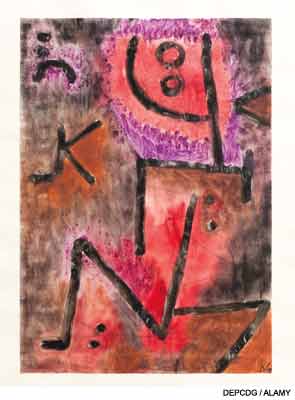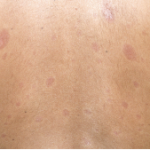

In its more aggravated forms, diffuse scleroderma is one of the most terrible of all human ills. Like Tithonus, to wither slowly, and like him to be beaten down and marred and wasted until one is literally a mummy, encased in an ever shrinking, slowly contracting skin of steel, is a fate not pictured in any tragedy, ancient or modern.
—Sir William Osler
The pain passes but the beauty remains.
—Pierre-Auguste Renoir
The great 20th century Swiss painter Paul Klee might have benefitted from the care of a rheumatologist. A complex and enigmatic artist, he left behind a staggering 10,000 pieces of art at the time of his death in 1940. He constantly experimented with new techniques and styles, drawing squares, triangles, or domes using sun-splashed colors. He believed that the role of abstract art was to create the reality behind visible things.1
In 1933, dark clouds were amassing over Germany. Klee refused to declare his loyalty to the newly installed Nazi regime and was dismissed from his job. The persecution intensified, and his works were removed from private and public German collections. Seventeen of his paintings, along with others produced by Pablo Picasso, Edvard Munch, and Marc Chagall, were included in Joseph Goebbels’ infamous Entartete Kunst (Degenerate Art) show. The exhibition, which was viewed by millions of Germans, was designed to ridicule and denigrate creative art that did not uphold “correct” National Socialist virtues. Most of the exhibit was burned in the courtyard of a Berlin fire station, and some pieces were auctioned off to the highest bidders.2
It was around this time that Klee, who had fled to Bern, Switzerland, became ill. He developed severe fatigue and a skin rash that his physicians speculated was due to measles. However, this would have been a rather unlikely diagnosis in a 56-year-old male. An alternative interpretation has been offered by an expert on Klee, our colleague, John Varga, MD, the John and Nancy Hughes Distinguished Professor in rheumatology at Northwestern University in Chicago. He hypothesized that Klee’s facial rash was caused by an eruption of telangiectasia, the earliest sign of what became a full-blown case of scleroderma.2 Within months, this avid hiker experienced exertional dyspnea and worsening dysphagia that restricted his diet to liquids. In his letters, he described having arthritic pain in his hands, making it difficult to hold a paintbrush. As Klee’s health declined, his friends, Pablo Picasso and Georges Braque, came to pay homage. Despite being given the diagnosis of scleroderma, Paul Klee was not done painting.

